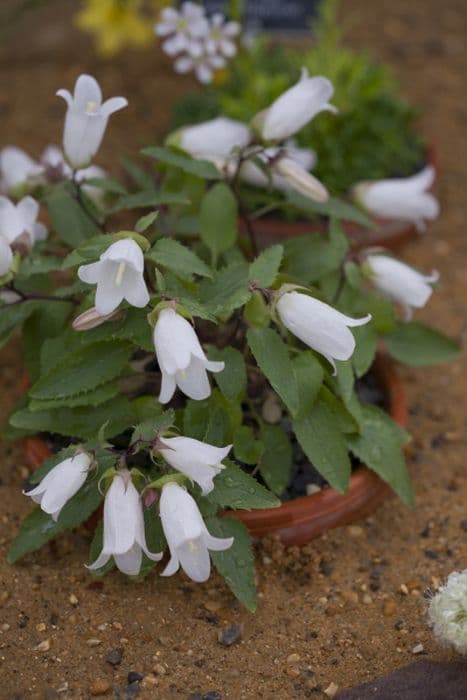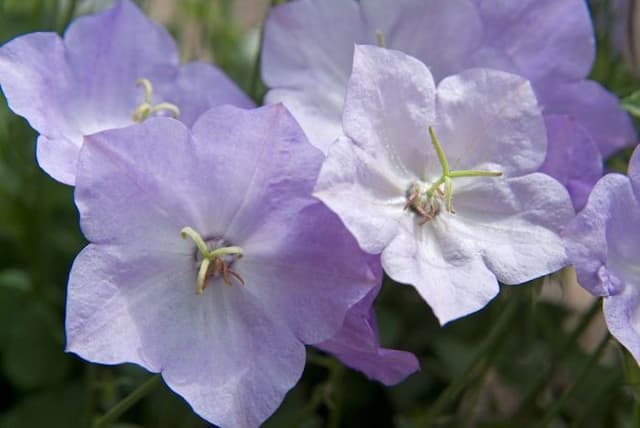Cardinal flower Lobelia × speciosa 'Kompliment Scharlach' (Kompliment Series)

ABOUT
The plant known as the Lobelia 'Kompliment Scharlach' from the Kompliment Series showcases a vibrant display with its eye-catching flowers and attractive foliage. The blooms are characterized by their rich, scarlet-hued petals that create an alluring contrast against the surrounding greenery. The flowers themselves are tubular and possess an elongated, elegant shape that tapers to a slight flare at the mouth, where delicate lobes can be noticed. These bright blossoms are densely clustered atop upright, strong stems, giving the impression of a sumptuous, colorful spike. The leaves that accompany these striking flowers are equally pleasing to the eye, typically taking on a lance-shaped form. These leaves are arranged in a way that they create a lush backdrop throughout the blooming seasons. Overall, the combination of fiery red flowers and verdant leaves results in a plant that radiates with a dynamic and dramatic flair in any garden setting where it's planted.
About this plant
 Names
NamesFamily
Campanulaceae
Synonyms
Cardinal Flower, Hybrid Lobelia, Lobelia, Speciosa Hybrid Lobelia
Common names
Lobelia × speciosa 'Kompliment Scharlach'
 Toxicity
ToxicityTo humans
Cardinal flower is generally considered to have low toxicity for humans. However, consuming parts of the plant can lead to undesirable symptoms such as nausea, vomiting, diarrhea, coughing, and excessive salivation if ingested in large quantities due to the presence of alkaloids. Care should be taken to prevent ingestion, particularly with children who might be tempted by the bright flowers.
To pets
Cardinal flower is also known to be of low toxicity to pets, but ingestion of parts of the plant, especially in large amounts, can cause symptoms such as vomiting, diarrhea, and excessive salivation in animals. It is advisable to keep an eye on pets when they are around such plants to avoid any potential health issues stemming from ingestion.
 Characteristics
CharacteristicsLife cycle
Perennials
Foliage type
Deciduous
Color of leaves
Green
Flower color
Red
Height
2-3 feet (60-90 cm)
Spread
1-2 feet (30-60 cm)
Plant type
Herb
Hardiness zones
6
Native area
Hybrid
Benefits
 General Benefits
General Benefits- Attractive Flowers: Produces striking, vibrant red flowers that are visually appealing and can enhance the aesthetic of gardens and landscapes.
- Attracts Pollinators: The flowers of Lobelia attract butterflies, hummingbirds, and bees, contributing to pollination and the overall health of the garden ecosystem.
- Easy to Grow: It is relatively easy to care for, making it suitable for gardeners of various skill levels.
- Adaptable: This plant can grow in a range of conditions, from full sun to part shade, and in various soil types.
- Drought Tolerant: Once established, it is somewhat drought-tolerant, reducing the need for frequent watering.
- Seasonal Interest: Provides color and interest in the garden throughout its flowering season, usually from midsummer to early fall.
- Compact Size: The plant's size is suitable for small gardens or containers, allowing it to be grown in a variety of spaces.
- Versatile Use: Can be used in borders, mixed beds, containers, and as cut flowers, offering versatility in landscaping and floral arrangements.
 Medical Properties
Medical PropertiesThis plant is not used for medical purposes.
 Air-purifying Qualities
Air-purifying QualitiesThis plant is not specifically known for air purifying qualities.
 Other Uses
Other Uses- As a natural fabric dye: The flowers of the Lobelia can be used to produce a subtle dye for fabrics, imparting a gentle hue to natural fibers.
- Photography subject: With its vibrant flowers, this plant serves as an excellent subject for photographers specializing in botanical and nature photography.
- Educational tool: Schools and universities might cultivate Lobelia as a living specimen to teach horticulture and botany students about hybrid plant varieties.
- Garden design theme: The Lobelia can be used to create a monochromatic garden theme, displaying various shades of red and scarlet flowers.
- Creative arts inspiration: Artists may draw inspiration from the plant's vivid colors and unique shape for paintings, textiles, or other art forms.
- Floral arranging: The Lobelia's striking blooms make it suitable for inclusion in floral arrangements, centerpieces, and bouquets.
- Seasonal celebrations: The red flowers could be used as part of decor for festivities, particularly those associated with summer or fall, aligning with the plant's blooming season.
- Butterfly and hummingbird gardens: Lobelia attracts pollinators, making it a valuable addition to gardens designed to attract butterflies and hummingbirds.
- As a living mulch: When planted densely, the Lobelia can act as a living mulch, covering the soil to help retain moisture and suppress weeds.
- Photoperiodic studies: The plant can be used in research to understand the effects of light periods on flowering, as Lobelia responds to photoperiods, which might help in agricultural improvement.
Interesting Facts
 Feng Shui
Feng ShuiThe plant Lobelia is not used in Feng Shui practice.
 Zodiac Sign Compitability
Zodiac Sign CompitabilityThe plant Lobelia is not used in astrology practice.
 Plant Symbolism
Plant Symbolism- Uniqueness and Distinctiveness: Lobelia, often known for its vibrant colors and unique floral shape, is associated with standing out from the crowd. The 'Kompliment Scharlach' Lobelia, with its striking scarlet flowers, especially embodies this trait, symbolizing a distinctiveness and a bold presence.
- Attraction and Magnetism: The bright, captivating flowers of the Lobelia can symbolize an irresistible allure and charm. This can be tied to its use as a focal point in gardens and its ability to draw the eye and attention of onlookers.
- Devotion and Loyalty: In floriography, or the language of flowers, lobelia represents devotion due to its perennial nature and its reliable blooming every season. It is often used to express steadfastness in friendship and love.
- Healing and Medicinal Properties: Historically, the lobelia plant has been used in herbal medicine. This heritage imparts a symbolic meaning of healing and wellness associated with the plant, although modern garden varieties like the 'Kompliment Scharlach' are cultivated more for ornamentation than herbal use.
 Water
WaterCardinal flowers should be watered regularly, aiming for a consistent moisture level without waterlogging the soil. During active growth in spring and summer, water thoroughly once a week, providing about 1-1.5 gallons per plant, depending on the size and environmental factors. In hotter, drier periods, this may increase to twice a week. Reduce watering frequency in the fall and further in winter to prevent soggy soil, as the plant's water needs decrease with cooler temperatures and reduced sunlight.
 Light
LightCardinal flowers prefer partial shade to full sun, thriving best in a spot that receives morning sunlight and afternoon shade. This light condition prevents the heat stress that can occur in hotter climates if exposed to the full harsh afternoon sun. An ideal location would offer filtered sunlight, as too much direct sun can scorch the leaves, while too little can lead to weak growth and fewer blooms.
 Temperature
TemperatureCardinal flowers are hardy and can tolerate a wide range of temperatures. They perform best in environments where temperatures remain between 60 to 80 degrees Fahrenheit. They can survive minimum temperatures down to about 20 degrees Fahrenheit but prefer not to be subjected to extended periods of freezing weather. Excessive heat above 90 degrees Fahrenheit can stress the plants, particularly if they are in full sun.
 Pruning
PruningPruning cardinal flowers involves deadheading spent blooms to encourage further flowering and prevent self-seeding if not desired. Regularly remove dead or yellowing leaves to maintain plant health and appearance. The best time for pruning is after flowering has ceased, in late summer or early autumn, which can also help to boost the next season's growth. Pruning back to the base in late winter or early spring prepares the plant for new growth.
 Cleaning
CleaningAs needed
 Soil
SoilCardinal Flower 'Kompliment Scharlach' thrives in moist, humus-rich, and well-draining soil. A good mix would be equal parts peat, loam, and sand to ensure proper drainage and root aeration. Incorporating compost into the mix can increase soil fertility. This plant prefers a slightly acidic to neutral pH, between 6.0 and 7.0.
 Repotting
RepottingCardinal Flower 'Kompliment Scharlach' generally needs repotting every 1-2 years to replenish nutrients and to accommodate root growth. Repot in the spring before the growing season begins, choosing a pot that's one size larger than the previous one.
 Humidity & Misting
Humidity & MistingCardinal Flower 'Kompliment Scharlach' will benefit from moderate to high humidity levels but is relatively adaptable. However, an environment with humidity levels of 50-70% is ideal for this plant to thrive.
 Suitable locations
Suitable locationsIndoor
Place in bright, indirect light with ample humidity.
Outdoor
Plant in partial shade, moist soil, and mulch to retain moisture.
Hardiness zone
4-9 USDA
 Life cycle
Life cycleLobelia × speciosa 'Kompliment Scharlach' (also known as Fan Scarlet Lobelia) begins its life cycle when seeds are sown, ideally in late winter to early spring under cover with warmth, as they require light to germinate. After germination, seedlings grow and establish a root system, and they should be gradually acclimatized to outdoor conditions before being planted out after the risk of frost has passed. In summer, Fan Scarlet Lobelia reaches the flowering stage, presenting striking scarlet blooms that attract pollinators and can last until the first frosts of fall. Following the blooming period, if conditions allow, it will produce seeds that can be collected for future sowing or left to self-seed in some cases. The plant will then either die back in the case of being treated as an annual or, if it is cultivated as a perennial in suitable climates, it will enter a period of dormancy during the colder months. With the return of warmer temperatures in spring, the plant will resume growth, completing its cycle.
 Propogation
PropogationPropogation time
Spring to Summer
Propogation: The most popular method of propagating the Lobelia × speciosa 'Kompliment Scharlach', commonly known as the Cardinal Flower, is by division. This is best done in the spring, just as new growth begins to appear. Carefully dig up the plant, preserving as much of the root system as possible. Using a sharp knife or spade, divide the crown of the plant into smaller sections, ensuring each has a portion of the root system. Replant the divisions immediately at the same soil depth as the original plant, and water them thoroughly to help establish their roots. Aim to space the divisions about 12 inches (approximately 30 centimeters) apart to give them room to grow. This method helps to maintain the vigor of the plants and also control their spread in the garden.









